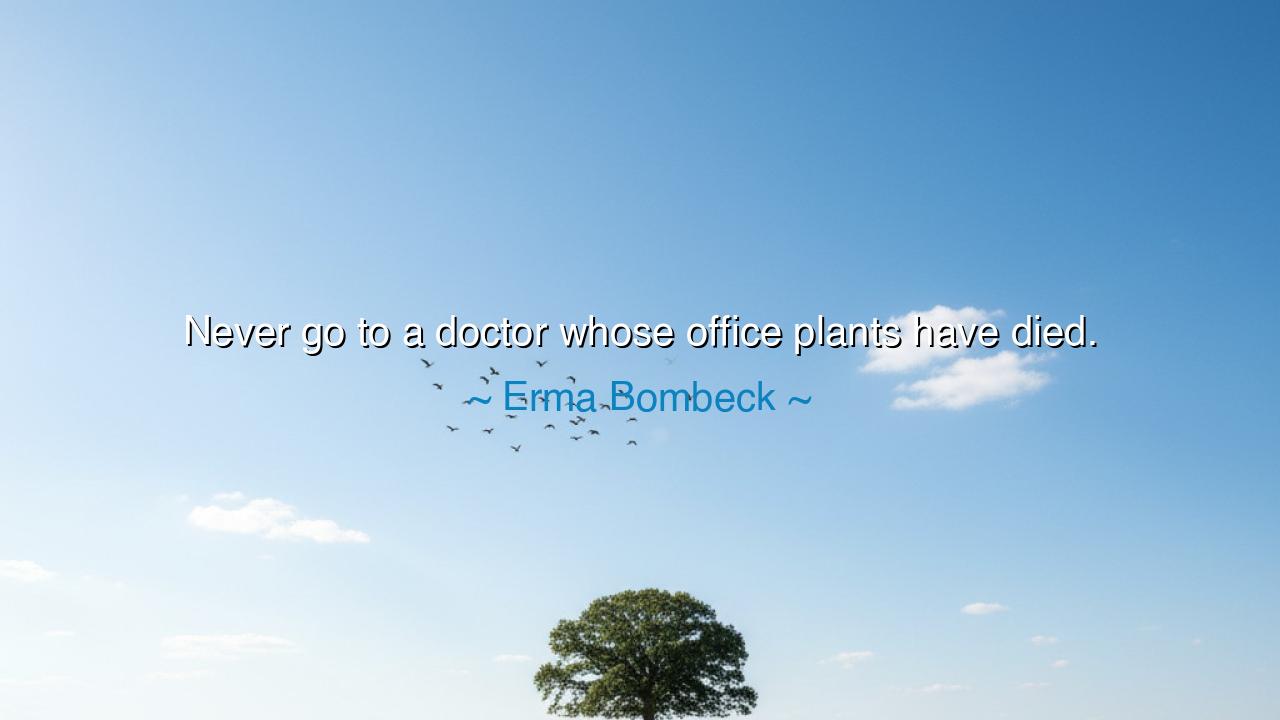
Never go to a doctor whose office plants have died.






The words of Erma Bombeck—“Never go to a doctor whose office plants have died.”—come to us wrapped in humor, yet beneath their jest lies a profound truth. At first, the saying stirs laughter, for who would judge a physician by the fate of a fern in his window? Yet in this playful image lies a lesson as old as wisdom itself: that the small signs in life reveal the great truths, and that the one who cannot tend to the fragile life of a plant may not be trusted with the greater burden of a human soul.
The ancients often looked for omens not in grand displays, but in small details. A crack in the wall of a temple, a bird circling the sky, a neglected hearth—these were seen as reflections of deeper order. So too here: a doctor’s plants are not merely decoration but testimony. If they wither from neglect, it speaks of inattentiveness, of a spirit hurried or careless. For to heal is not only the art of medicine but the art of care—to notice the quiet needs, to nurture life where it struggles, to guard the fragile with patience.
History gives us examples of this truth. In the days of Florence Nightingale, when soldiers lay in hospitals of filth and decay, it was not only scalpels and medicines that restored them, but the gentleness of order and the tending of the environment. Nightingale cleaned the wards, brought in fresh air, light, and even flowers. She understood that one who tends to the smallest details creates an atmosphere where healing can flourish. The withered plant in a physician’s office, then, becomes a symbol of a withered attention, and the wise heed such signs.
But Bombeck’s jest also carries a broader wisdom about character. For often the way a person treats what seems unimportant reveals how they will treat what matters most. The leader who ignores the poor will not govern with justice. The parent who neglects the small cries of a child cannot nurture its deeper needs. And the doctor who cannot keep life alive in his office may not keep hope alive in his patients. It is the law of the small things: that faithfulness in the little is the measure of trustworthiness in the great.
Yet let us not be too quick to condemn. For the dead plant may not always indict the physician’s skill, but it does awaken us to a vital truth: healing is not mere knowledge, it is compassion. The doctor who heals well is one who tends to life itself, in all its fragile forms. When we see one who cares for their surroundings, who brings life even into their workplace, we see one whose heart is attentive, whose spirit is mindful. And in such hands, both plant and patient may flourish.
The lesson for us is plain: look beyond words, beyond titles, beyond the outward claims of expertise. Look to the small signs that reveal a person’s care for life. Seek friends, leaders, healers, and companions who nurture what is entrusted to them, no matter how small. In your own life, do the same. Care for your space, your plants, your animals, your neighbors. For in learning to tend to what is fragile, you prepare yourself to handle what is great.
Thus, Bombeck’s humorous saying is more than laughter—it is an inheritance of wisdom. The dead plant in a doctor’s office is a warning: that neglect in the small leads to failure in the great. But the living, thriving plant is a sign of life-giving care. Therefore, let us cultivate attentiveness, let us cherish the small, and let us remember always that true healing begins not only in medicine but in the quiet art of nurturing life wherever it dwells.






AAdministratorAdministrator
Welcome, honored guests. Please leave a comment, we will respond soon